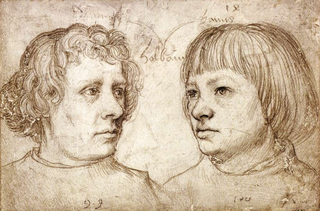
Ambrosius Holbein was a German and later a Swiss artist in painting, drawing, and printmaking. He was the elder brother, by about three years, of Hans Holbein the Younger, but he appears to have died in his mid-twenties, leaving behind only a small body of work.
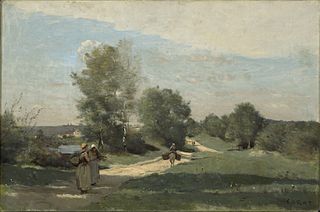
The Barbizon school of painters were part of an art movement toward Realism in art, which arose in the context of the dominant Romantic Movement of the time. The Barbizon school was active roughly from 1830 through 1870. It takes its name from the village of Barbizon, France, on the edge of the Forest of Fontainebleau, where many of the artists gathered. Most of their works were landscape painting, but several of them also painted landscapes with farmworkers, and genre scenes of village life. Some of the most prominent features of this school are its tonal qualities, color, loose brushwork, and softness of form.

Henri Julien Félix Rousseau was a French post-impressionist painter in the Naïve or Primitive manner. He was also known as Le Douanier, a humorous description of his occupation as a toll and tax collector. He started painting seriously in his early forties; by age 49, he retired from his job to work on his art full-time.
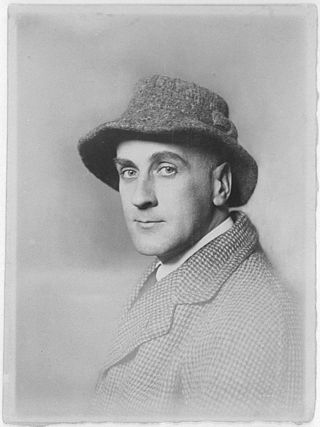
Wilhelm Uhde was a German art collector, dealer, author, and critic, an early collector of modernist painting, and a significant figure in the career of Henri Rousseau.

The Kunsthaus Zürich is in terms of area the biggest art museum of Switzerland and houses one of the most important art collections in Switzerland, assembled over time by the local art association called Zürcher Kunstgesellschaft. The collection spans from the Middle Ages to contemporary art, with an emphasis on Swiss art.

The Kunstmuseum Basel houses the oldest public art collection in the world and is generally considered to be the most important museum of art in Switzerland. It is listed as a Swiss heritage site of national significance.
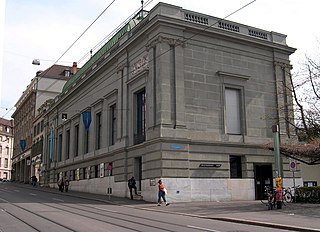
Kunsthalle Basel is a contemporary art gallery in Basel, Switzerland.

Karim Noureldin is a Swiss visual artist.

Irène Zurkinden was a Swiss painter.
Helmut Federle is a Swiss painter.

Colored Landscape with Aquatic Birds is an oil painting created circa 1907 by the French artist and theorist Jean Metzinger. Paysage coloré aux oiseaux aquatiques is a Proto-Cubist work executed in a Post-Divisionist style with a unique Fauve-like palette. Metzinger's broad omnidirectional brushstrokes in the treatment of surfaces render homage to Paul Cézanne, while the luscious subtropical imagery in the painting are an homage to Paul Gauguin and Metzinger's friend Henri Rousseau.
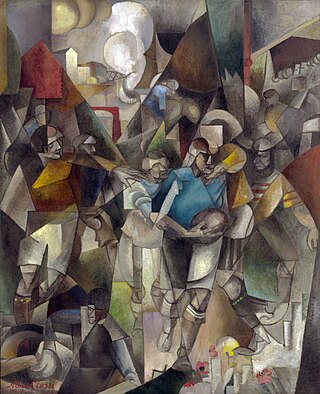
Football Players is a 1912–13 painting by the French artist Albert Gleizes. The work was exhibited at the Salon des Indépendants, Paris, March–May 1913. September through December 1913 the painting was exhibited at Erster Deutscher Herbstsalon, Berlin. The work was featured at Galeries Dalmau in Barcelona, 29 November – 12 December 1916, Gleizes' first one-person show. The work was again exhibited at Galeries Dalmau 16 October – 6 November 1926. Stylistically Gleizes' Football Players exemplifies the principle of mobile perspective laid out in Du "Cubisme", written by himself and French painter Jean Metzinger. Guillaume Apollinaire wrote about Les Joueurs de football in an article titled "Le Salon des indépendants", published in L'Intransigeant, 18 March 1913, and again in "A travers le Salon des indépendants", published in Montjoie!, Numéro Spécial, 18 March 1913.

Robert Genin was a Russian artist, painter, draftsman, and illustrator of Jewish origin, who lived in the Russian Empire, Germany, France, Switzerland and the USSR.
Rosa Lachenmeier is a Swiss painter and photographer whose work has been widely exhibited. She lives and works in Birsfelden near Basel.

Maja Sacher was a Swiss art collector and philanthropist.
Carl Christoph Friedrich Bernoulli was a Swiss art dealer and interior designer from the Bernoulli family of scholars.

Curt Glaser was a German Jewish art historian, art critic and collector who was persecuted by the Nazis.

In the 1967 Basel Picasso paintings purchase referendum, the people of Basel, Switzerland, voted for the purchase of two paintings by Pablo Picasso, Les deux frères (1906) and Arlequin assis (1923). The referendum took place on 17 December 1967, and the "yes" campaign was supported by the youth of Basel and the local football club FC Basel, among others. Picasso was astonished by the fact that people would vote in favor to buy his art in a majority vote, and invited Franz Meyer, the director of the Kunstmuseum Basel, to see him at his atelier in Mougins, where he presented the "Youth of Basel" with four more of his works.

In 1939 the Gallery Fischer in Lucerne organized an auction of degenerate art confiscated by the Nazis. The auction took place on 30 June 1939 in the Grand Hotel National. The auction received considerable international interest, but many of the bidders who were expected to attend were absent because they were worried the proceeds would be used by the Nazi regime.
Lotte von Mendelssohn-Bartholdy was a German author and art collector.
















